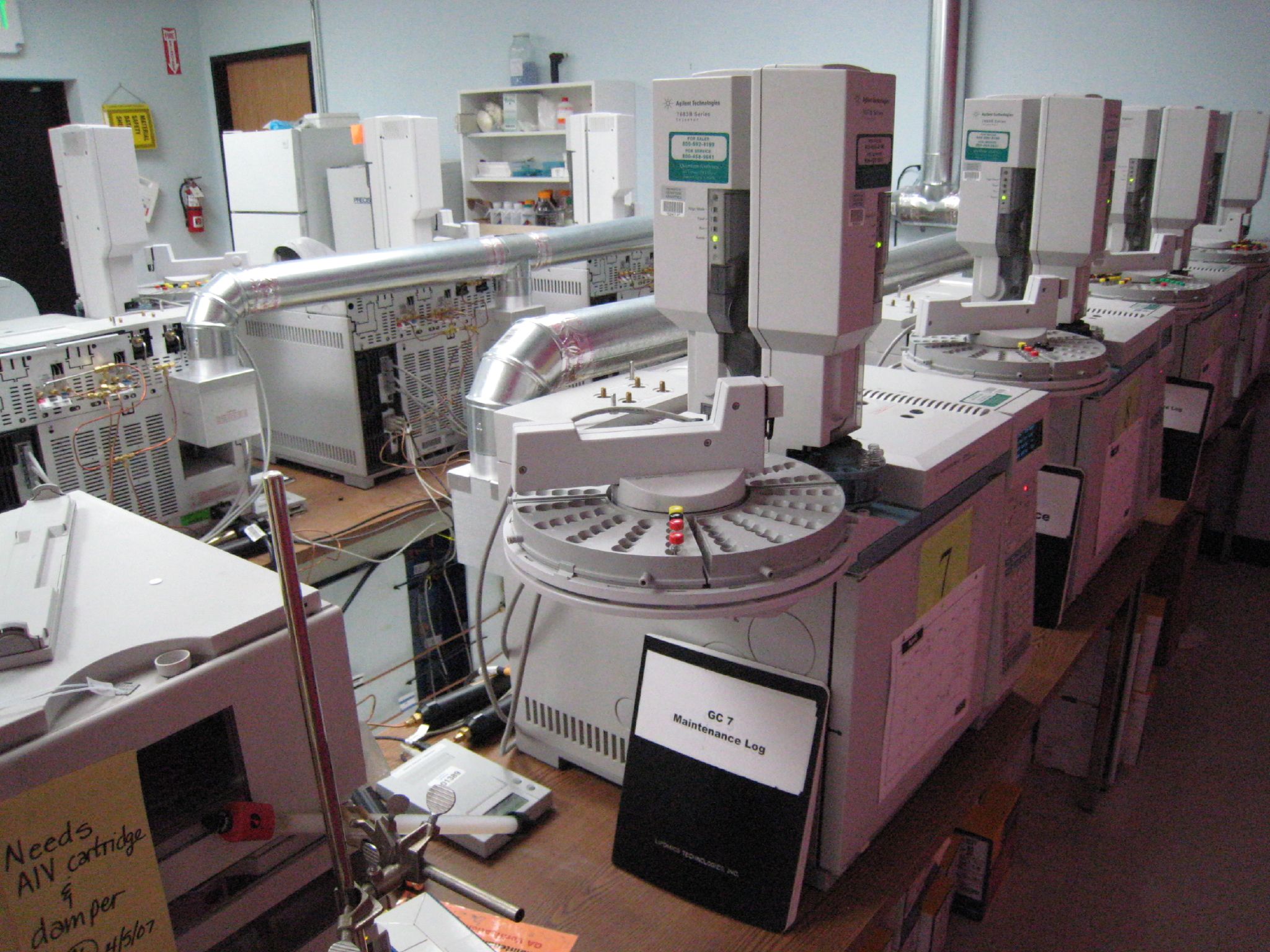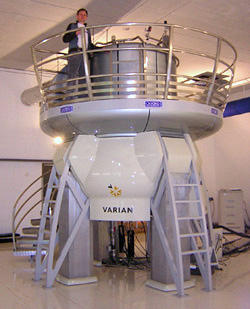|
NMR Spectroscopy Of Stereoisomers
Nuclear magnetic resonance spectroscopy of stereoisomers most commonly known as NMR spectroscopy of stereoisomers is a chemical analysis method that uses NMR spectroscopy to determine the absolute configuration of stereoisomers. For example, the cis-trans isomerism, ''cis'' or ''trans'' alkenes, ''R'' or ''S'' enantiomers, and ''R,R'' or ''R,S'' diastereomers.Frank J. Hollis. "NMR Through the Looking Glass: Uses of NMR Spectroscopy in the Analysis and Synthesis of Chiral Pharmaceuticals." 1994/ref> In a mixture of enantiomers, these methods can help quantify the optical purity by integrating the area under the NMR peak corresponding to each stereoisomer. Accuracy of integration can be improved by inserting a chiral derivatizing agent with a nucleus other than hydrogen or carbon, then reading the heteronuclear NMR spectrum: for example fluorine-19 NMR or phosphorus-31 NMR. Mosher's acid contains a -CF3 group, so if the adduct has no other fluorine atoms, the 19F NMR of a racemic mix ... [...More Info...] [...Related Items...] OR: [Wikipedia] [Google] [Baidu] |
Chemical Analysis
Analytical chemistry studies and uses instruments and methods to separate, identify, and quantify matter. In practice, separation, identification or quantification may constitute the entire analysis or be combined with another method. Separation isolates analytes. Qualitative analysis identifies analytes, while quantitative analysis determines the numerical amount or concentration. Analytical chemistry consists of classical, wet chemical methods and modern analytical techniques. Classical qualitative methods use separations such as precipitation, extraction, and distillation. Identification may be based on differences in color, odor, melting point, boiling point, solubility, radioactivity or reactivity. Classical quantitative analysis uses mass or volume changes to quantify amount. Instrumental methods may be used to separate samples using chromatography, electrophoresis or field flow fractionation. Then qualitative and quantitative analysis can be performed, often wi ... [...More Info...] [...Related Items...] OR: [Wikipedia] [Google] [Baidu] |
Fluorine-19 NMR
Fluorine-19 nuclear magnetic resonance spectroscopy (fluorine NMR or 19F NMR) is an analytical technique used to detect and identify fluorine-containing compounds. 19F is an important nucleus for NMR spectroscopy because of its receptivity and large chemical shift dispersion, which is greater than that for proton nuclear magnetic resonance spectroscopy. Operational details 19F has a nuclear spin (I) of and a high gyromagnetic ratio. Consequently, this isotope is highly responsive to NMR measurements. Furthermore, 19F comprises 100% of naturally occurring fluorine. The only other highly sensitive spin NMR-active nuclei that are monoisotopic (or nearly so) are 1H and 31P. Indeed, the 19F nucleus is the third most receptive NMR nucleus, after the 3H nucleus and 1H nucleus. The 19F NMR chemical shifts span a range of about 800 ppm. For ''organo''fluorine compounds the range is narrower, being about −50 to −70 ppm (for CF3 groups) to −200 to −220 ppm ( ... [...More Info...] [...Related Items...] OR: [Wikipedia] [Google] [Baidu] |
NMR Database Method
The nuclear magnetic resonance database method enables the identification of the stereochemistry of chiral molecules, especially polyols. It relies on the observation that NMR spectroscopy data depend only on the immediate environment near an asymmetric carbon, not on the entire molecular structure. All stereoisomers of a certain class of compounds are synthesized, and their proton NMR and carbon-13 NMR chemical shifts and coupling constants are compared. Yoshito Kishi's group at Harvard University Harvard University is a Private university, private Ivy League research university in Cambridge, Massachusetts, United States. Founded in 1636 and named for its first benefactor, the History of the Puritans in North America, Puritan clergyma ... has reported NMR databases for 1,3,5-triols 1,2,3-triols, 1,2,3,4-tetraols, and 1,2,3,4,5-pentaols.S. Higabayashi, W. Czechtizky, Y. Kobayashi, and Y. Kishi. "Universal NMR Databases for Contiguous Polyols." '' J. Am. Chem. Soc.'' 2003, ... [...More Info...] [...Related Items...] OR: [Wikipedia] [Google] [Baidu] |
Chiral Derivatizing Agent
In analytical chemistry, a chiral derivatizing agent (CDA), also known as a chiral resolving reagent, is a derivatization reagent that is a chiral auxiliary used to convert a mixture of enantiomers into diastereomers in order to analyze the quantities of each enantiomer present and determine the optical purity of a sample. Analysis can be conducted by spectroscopy or by chromatography. Some analytical techniques such as HPLC and NMR, in their most commons forms, cannot distinguish enantiomers within a sample, but can distinguish diastereomers. Therefore, converting a mixture of enantiomers to a corresponding mixture of diastereomers can allow analysis. The use of chiral derivatizing agents has declined with the popularization of chiral HPLC. Besides analysis, chiral derivatization is also used for chiral resolution, the actual physical separation of the enantiomers. History Since NMR spectroscopy has been available to chemists, there have been numerous studies on the applicatio ... [...More Info...] [...Related Items...] OR: [Wikipedia] [Google] [Baidu] |
Karplus Equation
The Karplus equation, named after Martin Karplus, describes the correlation between 3J-coupling constants and dihedral angle, dihedral torsion angles in nuclear magnetic resonance spectroscopy: :J(\phi) = A \cos\,2\phi + B \cos\,\phi + C where ''J'' is the 3''J'' coupling constant, \phi is the dihedral angle, and ''A'', ''B'', and ''C'' are empirically derived parameters whose values depend on the atoms and substituents involved. The relationship may be expressed in a variety of equivalent ways e.g. involving cos 2φ rather than cos2 φ —these lead to different numerical values of ''A'', ''B'', and ''C'' but do not change the nature of the relationship. The relationship is used for 3''J''H,H coupling constants. The superscript "3" indicates that a 1H atom is coupled to another 1H atom three bonds away, via H-C-C-H bonds. (Such H atoms bonded to neighbouring carbon atoms are termed Vicinal (chemistry), vicinal). The magnitude of these couplings are generally smallest w ... [...More Info...] [...Related Items...] OR: [Wikipedia] [Google] [Baidu] |
Line Broadening
A spectral line is a weaker or stronger region in an otherwise uniform and continuous spectrum. It may result from emission or absorption of light in a narrow frequency range, compared with the nearby frequencies. Spectral lines are often used to identify atoms and molecules. These "fingerprints" can be compared to the previously collected ones of atoms and molecules, and are thus used to identify the atomic and molecular components of stars and planets, which would otherwise be impossible. Types of line spectra Spectral lines are the result of interaction between a quantum system (usually atoms, but sometimes molecules or atomic nuclei) and a single photon. When a photon has about the right amount of energy (which is connected to its frequency) to allow a change in the energy state of the system (in the case of an atom this is usually an electron changing orbitals), the photon is absorbed. Then the energy will be spontaneously re-emitted, either as one photon at the same fre ... [...More Info...] [...Related Items...] OR: [Wikipedia] [Google] [Baidu] |
Signal-to-noise Ratio
Signal-to-noise ratio (SNR or S/N) is a measure used in science and engineering that compares the level of a desired signal to the level of background noise. SNR is defined as the ratio of signal power to noise power, often expressed in decibels. A ratio higher than 1:1 (greater than 0 dB) indicates more signal than noise. SNR is an important parameter that affects the performance and quality of systems that process or transmit signals, such as communication systems, audio systems, radar systems, imaging systems, and data acquisition systems. A high SNR means that the signal is clear and easy to detect or interpret, while a low SNR means that the signal is corrupted or obscured by noise and may be difficult to distinguish or recover. SNR can be improved by various methods, such as increasing the signal strength, reducing the noise level, filtering out unwanted noise, or using error correction techniques. SNR also determines the maximum possible amount of data that ... [...More Info...] [...Related Items...] OR: [Wikipedia] [Google] [Baidu] |
Mosher's Acid
Mosher's acid, or α-methoxy-α-trifluoromethylphenylacetic acid (MTPA) is a carboxylic acid which was first used by Harry Stone Mosher as a chiral derivatizing agent. It is a chiral molecule, consisting of ''R'' and ''S'' enantiomers. Applications As a chiral derivatizing agent, it reacts with an alcohol or amine of unknown stereochemistry to form an ester or amide. The absolute configuration of the ester or amide is then determined by proton and/or 19F NMR spectroscopy. Mosher's acid chloride, the acid chloride In organic chemistry, an acyl chloride (or acid chloride) is an organic compound with the functional group . Their formula is usually written , where R is a side chain. They are reactive derivatives of carboxylic acids (). A specific example o ... form, is sometimes used because it has better reactivity. See also * Pirkle's alcohol References {{Reflist Stereochemistry Carboxylic acids Trifluoromethyl compounds Phenyl compounds ... [...More Info...] [...Related Items...] OR: [Wikipedia] [Google] [Baidu] |
Phosphorus-31 NMR
Phosphorus-31 NMR spectroscopy is an analytical chemistry technique that uses nuclear magnetic resonance (NMR) to study chemical compounds that contain phosphorus. Phosphorus is commonly found in organic compounds and coordination complexes (as phosphines), making it useful to measure 31- NMR spectra routinely. Solution 31P-NMR is one of the more routine NMR techniques because 31P has an isotopic abundance of 100% and a relatively high gyromagnetic ratio. The 31P nucleus also has a spin of , making spectra relatively easy to interpret. The only other highly sensitive NMR-active nuclei spin that are monoisotopic (or nearly so) are 1H and 19F. Operational aspects With a gyromagnetic ratio 40.5% of that for 1H, 31P-NMR signals are observed near 202 MHz on an 11.7- Tesla magnet (used for 500 MHz 1H-NMR measurements). Chemical shifts are typically referenced to 85% phosphoric acid, which is assigned the chemical shift of 0, and appear at positive values (downfield of th ... [...More Info...] [...Related Items...] OR: [Wikipedia] [Google] [Baidu] |
Chiral Derivatizing Agent
In analytical chemistry, a chiral derivatizing agent (CDA), also known as a chiral resolving reagent, is a derivatization reagent that is a chiral auxiliary used to convert a mixture of enantiomers into diastereomers in order to analyze the quantities of each enantiomer present and determine the optical purity of a sample. Analysis can be conducted by spectroscopy or by chromatography. Some analytical techniques such as HPLC and NMR, in their most commons forms, cannot distinguish enantiomers within a sample, but can distinguish diastereomers. Therefore, converting a mixture of enantiomers to a corresponding mixture of diastereomers can allow analysis. The use of chiral derivatizing agents has declined with the popularization of chiral HPLC. Besides analysis, chiral derivatization is also used for chiral resolution, the actual physical separation of the enantiomers. History Since NMR spectroscopy has been available to chemists, there have been numerous studies on the applicatio ... [...More Info...] [...Related Items...] OR: [Wikipedia] [Google] [Baidu] |
NMR Spectroscopy
Nuclear magnetic resonance spectroscopy, most commonly known as NMR spectroscopy or magnetic resonance spectroscopy (MRS), is a spectroscopic technique based on re-orientation of atomic nuclei with non-zero nuclear spins in an external magnetic field. This re-orientation occurs with absorption of electromagnetic radiation in the radio frequency region from roughly 4 to 900 MHz, which depends on the isotopic nature of the nucleus and increases proportionally to the strength of the external magnetic field. Notably, the resonance frequency of each NMR-active nucleus depends on its chemical environment. As a result, NMR spectra provide information about individual functional groups present in the sample, as well as about connections between nearby nuclei in the same molecule. As the NMR spectra are unique or highly characteristic to individual compounds and functional groups, NMR spectroscopy is one of the most important methods to identify molecular structures, particularly of ... [...More Info...] [...Related Items...] OR: [Wikipedia] [Google] [Baidu] |



